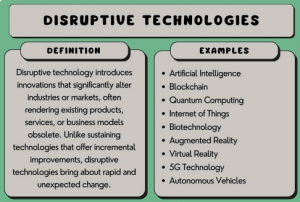Disruptive technologies, such as virtual reality (VR) or 3D printing, have the potential to significantly impact traditional business models across various industries. Here’s how these technologies can bring about transformation and change:

Disruptive Technologies On Traditional Business Models
Table of Contents
Toggle1. Virtual Reality (VR):
- Retail and E-Commerce:
- VR can revolutionize the retail experience by offering virtual storefronts where customers can explore and interact with products in a 3D environment. This challenges traditional brick-and-mortar retail models.
- Real Estate:
- Virtual property tours using VR technology can disrupt the traditional real estate industry. Prospective buyers can explore homes remotely, potentially reducing the need for physical visits.
- Education and Training:
- VR can transform traditional education models by providing immersive learning experiences. Virtual classrooms and hands-on training simulations can enhance the educational process.
- Healthcare:
- In healthcare, VR can be used for remote patient monitoring, virtual surgeries, and therapy sessions. This has the potential to change the traditional patient-doctor interaction.
- Entertainment and Events:
- VR experiences in gaming, concerts, and events challenge traditional entertainment models. Virtual attendance can become a viable alternative to physical presence.
- Collaboration and Communication:
- VR facilitates virtual meetings and collaborative work environments. This challenges traditional office-based work models and enables global collaboration without physical proximity.
2. 3D Printing:
- Manufacturing and Supply Chain:
- 3D printing disrupts traditional manufacturing methods by enabling on-demand production. This reduces the need for large-scale production facilities and changes traditional supply chain models.
- Customization and Personalization:
- Traditional manufacturing often involves mass production with limited customization. 3D printing allows for personalized and customized products, challenging the one-size-fits-all approach.
- Healthcare and Biotechnology:
- 3D printing is used in medical applications, such as creating customized prosthetics, implants, and even human tissue. This disrupts traditional healthcare models by introducing personalized medical solutions.
- Construction and Architecture:
- In construction, 3D printing can be employed to create intricate and custom structures. This challenges traditional construction methods and opens up possibilities for innovative architectural designs.
- Automotive Industry:
- 3D printing in the automotive industry allows for the production of customized and lightweight components. This challenges traditional manufacturing processes and materials.
- Aerospace:
- 3D printing is transforming the aerospace industry by enabling the production of complex and lightweight components. This disrupts traditional manufacturing in the aerospace sector.
- Consumer Products:
- 3D printing allows consumers to create or customize products at home. This challenges traditional retail models by decentralizing production.
Overall Impact on Traditional Business Models:
- Supply Chain Disruption:
- Both VR and 3D printing can disrupt traditional supply chains. VR can reduce the need for physical products, while 3D printing allows for decentralized and on-demand production.
- Shift in Consumer Expectations:
- Consumers exposed to VR and 3D printing may come to expect more personalized, immersive, and customizable experiences. Businesses that fail to adapt may struggle to meet changing consumer demands.
- New Business Models:
- These technologies open up opportunities for entirely new business models. For example, companies may emerge that specialize in creating VR content or providing 3D printing services.
- Efficiency and Cost Savings:
- Both VR and 3D printing can contribute to increased efficiency and cost savings. VR can reduce the need for physical infrastructure, and 3D printing can streamline production processes.
- Redefining Industries:
- Industries that embrace these disruptive technologies can redefine their practices. For example, traditional learning institutions may need to adapt to virtual education, and manufacturers may need to shift to more flexible and customized production methods.
While these disruptive technologies present challenges, they also offer opportunities for innovation and growth. Businesses that strategically incorporate VR, 3D printing, and other disruptive technologies into their operations can stay ahead of the curve and thrive in a rapidly evolving business landscape.
